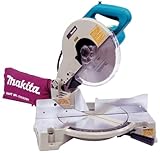Makita LS1040 10-Inch Compound Miter saw
Product Information / Description
Makita LS1040 10-Inch Compound Miter saw

|
List Price: $329.80 Sale Price: $189.99 Availability: Usually ships in 24 hours Eligible For Free Shipping 

|
Product Description
A favorite on job sites, Makita's 10-inch compound miter saw has a highly dedicated following. Even though it's extremely portable (at 24.2 pounds), Makita's saw also boasts a super sturdy dual-post pivoting arm. A pivot fence adjusts for supporting large stock and flips back for bevel cuts. The saw bevels left up to 45 degrees and miters 45 degrees left and up to 52 degrees right. There's no lack of power here, either: a 15 amp motor spins the blade, plus there's an electric brake that saves you time between cuts. There's also a shaft lock that makes changing blades quick and easy. The miter has a smooth-action swivel, but the lock is of the older screw-handle design that's a little more time-consuming than the newer (and more expensive) cam-lock designs. This Makita also lacks a soft-start mechanism, so it does jump a bit when the motor first engages; some users swear by a soft start, but we think a saw can still be a high-quality saw without one. Makita's saw has a vertical grip design with a thumb-activated safety switch and a paddle trigger, and while the vertical design might be slightly less ergonomic than the horizontal D-handle, it does allow you to use the saw comfortably with either hand. And the paddle grip makes squeezing the trigger easy no matter how you're holding the handle. Our verdict: it's a solid saw. -- Jon Groebner
Choosing a Miter Saw
Miter saws are versatile tools that have become a mainstay of workshops everywhere. These powerful saws make angled cuts by pulling a circular blade down onto a workpiece with a short, controlled plunge. It might appear that miter saws are infinitely complex and varied, but there are only three general types. The type you choose will depend on your woodworking needs.
Basic Miter Saws
Basic miter saws are the least versatile off the three major variations, but they’re a great starting point for novice do-it-yourselfers. These models typically adjust for miter cuts only, so consider upgrading if you need to do more than that.
Compound miter saws are easier to use than basic miter saws because you can place your stock flat for cutting, and they adjust simultaneously for miter and bevel cuts. A compound miter saw is great for jobs that feature stock that's not very tall or wide, such as door and window trim or picture frames.
Sliding Compound Miter Saws
Sliding compound miter saws are the most versatile of the available models. They have a motor and blade assembly that's mounted on a moveable arm to accommodate longer, wider workpieces. For smaller pieces, the saw performs like an ordinary fixed-head model. On some models, the blade can only pivot in one direction, but on a dual sliding compound miter saw, the blade can tilt to the right or left.
Important Features at a Glance
Though models will vary by manufacturer and design, these are a few of the more commonly found features that you might want to keep in mind.
- Electric brake: Reverses the flow of electricity when the saw's trigger is released. This is an important safety feature that slows the blade quickly in case of emergency.
- Blade guard: Most miter saws have self-retracting guards that withdraw when the saw is lowered for use, and reappear when it is raised.
- Laser guide: Gives a precise visual line where the cut will occur on your workpiece.
- Dust bag: Helps collect sawdust for a clearer, more tidy cutting area.
- Shaft lock: Immobilizes the shaft and blade for quicker, easier blade changes.
- Table extensions: Mount on either side of the saw to help balance longer workpieces.
Miter Saw Blades
Miter saw blades come in a variety of different sizes, grades, and materials, but there are three main types: steel, high-speed steel, and carbide-tipped blades.
- Steel: Inexpensive and good for cutting soft woods or plywoods. Sharpness diminishes quickly in tougher materials.
- High-Speed Steel: More rugged than steel blades, and great for cutting harder woods.
- Carbide-Tipped: More expensive than other blades but much more durable. Maintain sharpness over a longer period.
Details
- Features powerful 15 amp motor and dual post compound pivoting arm
- Provides a large capability with cuts 52 degrees right and 47 degrees left with 9 positive stops at 15, 22-1/2, 30, 45 degrees left or right and 0 degrees
- Durably designed with a machined aluminum base, dual aluminum base, dual slide rails and a carbide tip blade
- Saw includes vertical vise, blade, wrench and triangular rule
- Covered by 1-Year warranty






